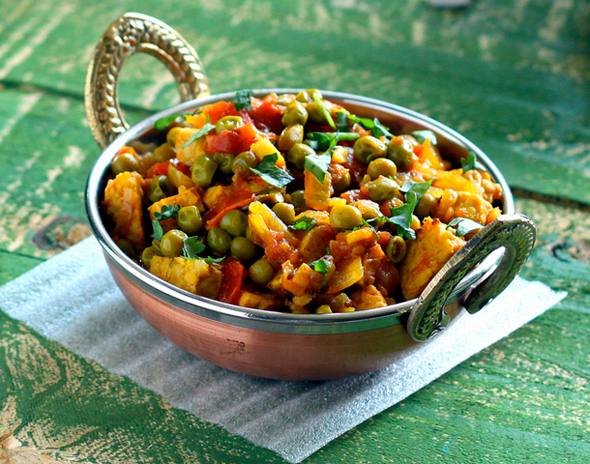Mama’s Punjabi Recipes: Sukha Mutter Paneer (Sauteed Peas And Cheese)
The lowly vegetable mutter (peas) is used in many Indian dishes in one form or the other as a complement to other main ingredients, but seldom as the main dish. Peas are prized for tenderness in bringing a gentle texture to aaloo (potatoes), briyanis (rice palaos), paneer (cheese) or khumbhan (mushrooms). They are even used as fillings for samosas (fried pies) and kachoris (fried balls). Small young peas are even dried and fried into a snack or split into a mutter di daal (split pea lentil).
The earliest archaeologist finds of peas dates back to over 9,000 BC in current Greece, Syria, Turkey and Jordan and in Egypt in 4,800 BC. They were found in Harrapa in 2,250 BC and appeared in Uttar Pradesh in 200 BC. Raw peas are starchy but high in carbohydrates, calcium, phosphorus, potassium, magnesium and vitamin C. Paneer is likewise high in carbohydrates but also high in calcium and sodium.
Paneer is an unaged, acid-set, non-melting farmer cheese made by curdling hot milk with lemon juice or vinegar to separate the whey. Paneer is a favorite all over India, and is on most restaurant menus, in one dish or the other, often with additional thickening cream; the most favorite for young and old alike being palak paneer (spinach and cheese). In addition, there are large paneer pakoras, paneer samosas, paneer paranthas and of course, the sweetmeats like ras mallayi or ras gullas. McDonalds India even serves a McSpicy Paneer and Paneer Wrap.
In the Punjab, mutter paneer (peas and cheese) is a favorite which most families make at home usually. This recipe as it is both easy to make and still has lots of flavor and can be eaten with roti. As it doesn’t have any curry to it, it is also fast to make.
Ingredients:
200 gm mutter (green peas) – frozen or fresh
250 gm paneer (Indian cheese) – cut into square cubes
1 small pyaaz (onion) – peeled and finely chopped
1 clove of lasan (garlic) – peeled and finely chopped
1 small piece of adrak (ginger) – peeled and finely chopped
1 cup garam pani (warm water)
1 tbsp tamater paste (tomato paste)
3 tablespoons of vegetable or olive oil
Spices (to taste): namak (salt), mirch (red pepper), haldi (turmeric), fresh dhania (coriander), garam masala
Directions:
1. Prepare the masala in a medium saucepan. Heat 2 tablespoons of oil over medium heat, then add the onions, ginger, garlic and tomato paste. Stir well to make sure it doesn’t stick to the bottom. When the mixture is slightly reddish brown, add the salt, pepper and haldi and stir well.
2. Throw in the peas and stir well to coat and cook for a few minutes. If frozen, then let the peas thaw out first before using and cook for 5 minutes. If fresh, then let the peas cook a little longer in the saucepan.
3. Throw in the paneer and stir to coat well and let it cook for 2 minutes.
4. Add warm water and bring it to a boil for 5 minutes. Turn the heat off, cover the saucepan and let it sit for five minutes.
5. Before serving, garnish the dish with garam masala and the shredded fresh dhania.
MAMA’S TIP OF THE WEEK
PREPARE EXTRA CURRY MASALA AND KEEP IT READY FOR QUICK COOKING
There are times when a visitor shows up unannounced or you have to entertain friends or family in a hurry. At these times, you may not have enough time to cook everything from scratch, especially the masala which is the core of all Punjabi dishes.
For all those moments, just cook up some extra masala and either freeze it or keep it handy in the fridge for easy use. Peel and chop 1 large pyaaz (onion), 2 cloves of lasan (garlic) and 1 medium adrak (ginger); brown in a medium frying pan with 4 tablespoons of oil over medium heat; add 1 small tamater (tomato) or 1 teaspoon tomato paste; then add namak (salt), mirch (red pepper), haldi (turmeric) and garam masala to taste.

Shakuntla Malhotra is a skilled cook of Punjabi dishes made in the old-fashioned style that she learnt as a young woman in her ancestral home in Lyallpur (since renamed Faisalabad), India before it became part of Pakistan after the Partition in 1947. People have often admired her cooking for its simplicity and taste that comes with each mouthful. Even in her mid-eighties, she continues to cook daily and agreed to share some of her delectable Punjabi recipes.

